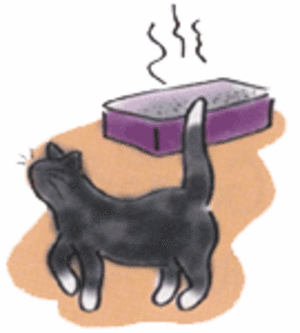During my college years, I managed to have a cat or two or three. I never took the time to teach the darn things to use a litter box, which probably explains why they crapped all over my apartment. Not a nice thing — especially when you walk around barefoot all the time.
But I digress. You gotta hand it to cats. Unlike dogs and small children — a cat actually knows instinctively that it should bury its waste in soft, diggable material such as that found in a litter box. So in a sense, ‘ol Mother Nature has already helped you get the entire littler-box training process started. (and for the record, I’m convinced that dog’s just instinctively know to stick their nose in your crotch).
Anyway, just because the cat has the instincts to bury its waste doesn’t mean it has the actually street smarts to use the liter box in your house or wherever you happen to put it. Whether you are dealing with a young kitten that is still learning proper bathroom etiquette or an older cat who has decided it doesn’t want to use the litter box any more and roam free – there are certainly things you can do to encourage faithful litter box use.
According to www.perfectpaws.com, the first thing you may want to do — and this s especially true when dealing with a kitten — is to have scheduled feeding times throughout the day. If anything — this will let YOU know when your kitten needs to go to the restroom.
Secretsofcats.com points out that it’s much easier to predict when a kitten is going to start looking for a place to rid itself because kittens typically need to relieve themselves anywhere from 5 to 25 minutes after eating. As the cat gets older, bathroom time will be harder to predict — but through careful and persistent observation you will be able to pick up a trend. And trust me – you’ll want to do this because the alternative is finding cat poop all over your house.
O-k…so a young cat is going to eat 3 to 4 times a day, and as a rule-of-thumb about 5 to 15 minutes after the cat eats you should gently place the kitten in the litter box. Why wait. If you see the kitten sniffing around and showing signs that it wants to relieve itself, gently pick up and place the kitten in its litter box. Yelling, scolding or swatting the cat will do absolutely no good. Such behavior from humans typically reserved for their children will only make a cat fear its owner. What’s more, many vets feel that if you scold the kitten or cat and then put them in the liter box they will associate the litter box with punishment.
And go figure — just like kids and dogs – a little positive reinforcement goes a long way. It’s always a good idea to reward your cat or kitten with a treat or lots of praise.
More vet tips:
Make sure the litter box fits the cat. You don’t want something that looks like half and acre when all you have is a tiny kitten. Conversely, a large cat may get frustrated if it doesn’t have room to scratch and dig in.
Some vets also recommend that you don’t stare at cats while they poop. Apparently this very independent creature can get a complex if it knows you’re watching and that may prevent it from pooping in the litter box also.
If you keep finding cat-poop beside the litter box rather than in it, it might just be a size issue. The box isn’t big enough to contain the cat – so switch to something with more room.
Your cat does not simply need a litter box points out www.perfectpaws.com – it needs a clean litter box with fresh litter. Your cat will be inhibited from using her litter box if it smells of urine. Think about it from the cat’s viewpoint. When she soils your dining room carpet, the area is immediately and thoroughly cleaned. Given the choice between a regularly cleaned place and a litter box that gets changed only once or twice a week, your cat will naturally prefer the carpet.
The litter box must be cleaned daily. The old litter must be discarded and replaced with about 1 1/2 inches of fresh litter. Rinse the litter box thoroughly with water. Adding a little vinegar or lemon juice to the water will help neutralize the odor of the cat’s urine. Do not use ammonia; this will make the litter box smell worse.
Make sure that the litter box is in an appropriate place. Cats do not like to soil the areas close to their sleeping or eating areas, so place the litter box some distance away. However, do not place the litter box in an area that is too inaccessible. For example, if the litter box is placed in the bathroom, make sure the door cannot swing shut preventing the cat from getting to it. If the cat is new to your home, she may go into hiding for a few days so place a litter box close to her hiding place.
Some additional x-factor may be inhibiting your cat from using her litter box, so put down an extra one in a different location. If there is more than one cat in the house, have several litter boxes available.
I’ve had cats enough times to know that they really are just guests. They’re just passing through. We want to think that they love us but they are just living in our homes or apartments because it’s a free meal and a place to stay. There’s nothing wrong with that — so why not make their stay a happy one and keep tabs on tabby’s litter box.



